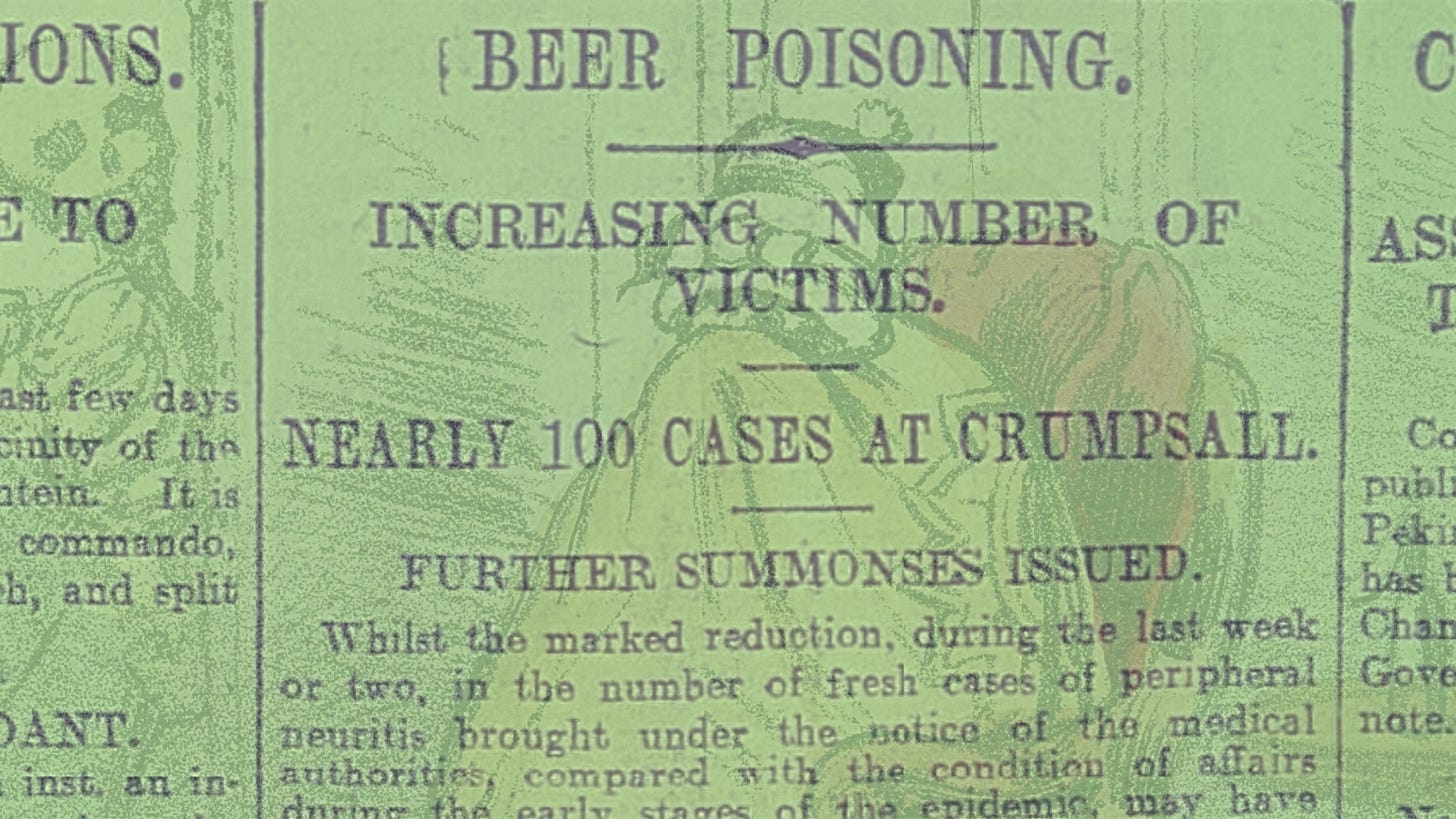The Manchester beer poisoning scandal
Hundreds of people became sick and dozens died before deadly arsenic was found in the city's beer supply
Like many working people at the turn of the twentieth century, Annie Gledhill was reluctant to tell a doctor she liked a drink.
Admitting she supped four cups of beer before bed to ease her bronchial cough might have left her liable to having her children taken.
So every time she was seen by Mr Allen at Hulme Dispensary about the pains in her legs, Annie swore on the Bible she was teetotal.
The experienced house surgeon had his own opinion.
Annie had all the signs of a condition called peripheral neuritis — alocohol-induced damage to the nerves in the hands and feet.
Growing increasingly paralysed before she died, she could have been chalked off as just another casualty of the demon drink.
But Annie was the victim of a hidden scandal affecting hundreds of women in Manchester.
The cheap beer she drank each night with her supper had been poisoned with arsenic.
Dear reader — If you’ve been enjoying the newsletter, please consider going paid to help me keep it going. It’s just a few pounds a month, and it genuinely makes a difference. Check out your subscription options here — you can unsubscribe any time, with one click.
Around the time that Annie died in December 1900, Mr Allen began to notice a sudden spike in similar cases.
He and other doctors in the city realised their patients were being poisoned by arsenic — another cause of peripheral neuritis — that had somehow found its way into the beer they were drinking.
Nearly all of the sufferers were women. Out of up to 40 cases Allen had seen in recent weeks, only three of them were men.
The women were the worst affected because they could only afford the cheapest beer — the type that had been poisoned.
“My experience is that the cheaper the beer, the worse the case,” Allen told the inquest into Annie’s death.
It was another medic named Ernest Reynolds who finally hit the nail on the head — four months after the epidemic began — when he realised that people who only drank spirits were being affected less than beer drinkers.
By that December, the poisoning outbreak had become a full blown panic.
“There are several hundred patients being treated by the hospitals,” the Umpire newspaper wrote.
“There are 60 patients in the Withington Workhouse Hospital and at the Salford Union Infirmary there are 28 females and 21 males.
“There are a number of cases at the Crumpsall Workhouse Hospital and Ancoats Hospital.”
By 3 January, Crumpsall’s medical officer Dr Sissons confirmed the mass poisoning was even worse than thought.
“There are between 80 and 100 patients at Crumpsal Workhouse Hospital,” he said.
“We have admited six or eight in the last two days.”
The doctors’ task was made harder by the fact that the patients they were treating continued to remain reluctant to reveal if they had been drinking.
Such as the stigma inflicted on women in particular over the use of alcohol that they refused to admit it.
“I tell you we cannot get much out of these people,” the city coroner told the jury at one case. “They will not say there has been any beer drinking.”
Inquests were held on the deaths of four patients at Crumpsall who had all died as a result of arsenic beer poisoning.
Catherine Wood, a woman inmate at Strangeways jail, was among others who died.
In Urmston, a husband reluctantly testified at the inquest of his wife, Elizabeth Wilcox, that she “had been in a habit of taking whisky, but only occasionally drank draught beer”.
The inquest found she had suffered heart failure, with arsenical-induced peripheral neuritis being the cause.
With police trying to find who had poisoned the city’s beer, more than a dozen landlords were hauled before magistrates for offences under the Sale of Food and Drugs Act.
In Cheshire, the county council tested nearly 200 samples of beer and found nearly all of them tainted with arsenic.
It was only later that the cause of the poisoning was finally found.
A manufacturer of brewing sugar was discovered to have used ingredients that contained large traces of arsenic.
The sugar was then used by breweries to make the cheapest ales drunk by working women mainly around Manchester.
“I’m struck by the fact that all the deaths which have come before the court have been those of people who were in poor circumstances,” the coroner at the inquest of a woman named Mary Lee said.
He said her death in Back Style Street, Angel Meadow, was one of the worst cases he had seen.
Angel Meadow tours and more…
Thank you to the nearly 600 people who have joined me on my Angel Meadow walking tour this year and last year.
I’m only running a few more dates this year so, if you enjoyed the tour and want to recommend it to a friend, please do check out the last available dates of 2025 by visiting my ticketing website or click on the button below.
These will be the last few dates before the winter, when I’ll be taking a break from the tours and deciding my plans for next year.
With autumn approaching, I’ll also be running two masterclasses in September aimed at helping people with their family history research.
2 September: Finding Your Irish Ancestor’s Townland
9 September: Investigating Your Criminal Ancestors
Places on both class are limited but if you’re not a paid subscriber to this newsletter, you can click on the button below if you want to buy a ticket for either class.
Paid subscribers to this newsletter can get access to both classes for free by emailing me at manchesterhistoryclub@gmail.com before 10 August letting me know which class (or both) you want to attend.
Have a great weekend!











Very interesting!